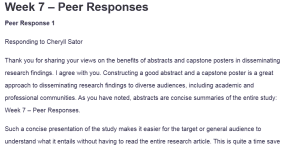Week 7 – Peer Responses
Peer Response 1
Responding to Cheryll Sator
Thank you for sharing your views on the benefits of abstracts and capstone posters in disseminating research findings. I agree with you. Constructing a good abstract and a capstone poster is a great approach to disseminating research findings to diverse audiences, including academic and professional communities. As you have noted, abstracts are concise summaries of the entire study: Week 7 – Peer Responses.
Such a concise presentation of the study makes it easier for the target or general audience to understand what it entails without having to read the entire research article. This is quite a time save for many who may not have enough time to follow up with the entire study or read an entire research article. Abstracts are useful in screening for articles during the development of systematic and rapid reviews saving researchers time while reducing the risk of missing out on relevant articles (Gates et al., 2020). It is quite interesting how you have presented capstone posters as visual abstracts of the project.
This is quite true as such posters focus more on the use of concise texts and graphics to communicate information. This is quite true as they make the information more visually appealing hence, making them more effective in communicating intended information to the target audience (Günay, 2021). Both abstracts and capstone posters being concise are as you have noted; effective tools for communicating complex information in an easier to more understandable format.
Such conciseness and effectiveness in communication further improve how information on the study including its findings is accessed and interpreted by readers. Therefore, they improve the accessibility and readability of research articles. Hence, making them beneficial and effective in communicating project findings.
References
Gates, A., Gates, M., Sebastianski, M., Guitard, S., Elliott, S. A., & Hartling, L. (2020). The semi-automation of title and abstract screening: A retrospective exploration of ways to leverage Abstrackr’s relevance predictions in systematic and rapid reviews. BMC Medical Research Methodology, 20(1), 1–9. https://doi.org/10.1186/S12874-020-01031-W/TABLES/4
Günay, M. (2021). Design in Visual Communication. Art and Design Review, 09(02), 109–122. https://doi.org/10.4236/ADR.2021.92010
ORDER A PLAGIARISM-FREE PAPER HERE
We’ll write everything from scratch
Question 
PEER RESPONSE 1:
Cheryll Sator posted Nov 12, 2024 9:06 AM
The construction of abstracts and capstone posters serves as vital tools for effectively disseminating research findings to diverse audiences within the academic and professional communities. A well-crafted abstracts function as concise yet comprehensive summaries that allow readers to quickly grasp the essential elements of a research study, including its purpose, methodology, results, and implications (Bahadoran et al., 2020). This accessibility promotes broader engagement with research findings and facilitates knowledge transfer across disciplines.
On the other hand, capstone posters provide a visual platform or commonly referred to as visual abstracts that transforms complex research data into easily digestible formats through strategic use of graphics, charts, and organized text (Millar & Lim, 2022). In order to facilitate the dissemination of valuable research findings, medical journals and organizations are increasingly incorporating visual abstracts.

Week 7 – Peer Responses
Multiple pathways for research dissemination are established by the combination of abstracts and posters. Abstracts are searchable database entries that enhance the visibility of research and its citations, whereas posters facilitate face-to-face interaction and networking opportunities at academic conferences. This dual approach expands the dissemination and influence of research findings across a variety of platforms and audiences.
The act of composing abstracts and posters is essential for the development of essential skills in the effective communication of complex ideas and the synthesis of information. By increasing the accessibility of research findings to practitioners, policymakers, and other stakeholders who may not have the time to peruse the complete research papers, these formats democratize access. Faster implementation of evidence-based practices in real-world settings may result from this enhanced accessibility.
